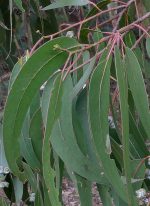 A native of Australia, Tasmanian blue gum has naturalized in coastal grasslands and shrublands, riparian areas and moist slopes of California. It was introduced there in the mid 1800s partially to fill the need of the Southern Pacific Railroad for timber but by the late 1800s was also used for windrows to protect citrus groves, especially in Orange County. With exfoliating bark and attractive evergreen blue-gray foliage, it has become a popular part of the landscape but because of its high reproductive capacity and role in wild fires is now considered invasive especially along the coast where moisture is available for propagation. The trees are fast growing and very tall, growing up to 180’ with the tallest measuring 331’. They have extensive roots systems that can be helpful for reclaiming wetlands but can also damage pipes and house foundations. USDA Hardiness Zones 8-10The following native plants are recommended as alternatives:
A native of Australia, Tasmanian blue gum has naturalized in coastal grasslands and shrublands, riparian areas and moist slopes of California. It was introduced there in the mid 1800s partially to fill the need of the Southern Pacific Railroad for timber but by the late 1800s was also used for windrows to protect citrus groves, especially in Orange County. With exfoliating bark and attractive evergreen blue-gray foliage, it has become a popular part of the landscape but because of its high reproductive capacity and role in wild fires is now considered invasive especially along the coast where moisture is available for propagation. The trees are fast growing and very tall, growing up to 180’ with the tallest measuring 331’. They have extensive roots systems that can be helpful for reclaiming wetlands but can also damage pipes and house foundations. USDA Hardiness Zones 8-10The following native plants are recommended as alternatives:
Pacific Madrone (Arbutus menziesii)
A tall evergreen tree, Pacific madrone is up to fifty feet tall and has cinnamon-colored exfoliating bark, glossy green leaves that turn burgundy to yellow before dropping in the spring, and sprays of white bell-shaped flowers in spring followed by bright red berries. Trees are native to open woods, stream banks, and outcroppings from British Columbia south to Baja California. USDA Hardiness Zones 7-9
Arizona Cypress (Cypressus arizonica)
Growing up to sixty feet, this conical conifer has fine textured needles and richly colored exfoliating bark. It is native to woodland edges, clearings, rock outcroppings from Texas west to Utah and California, south to central Mexico. USDA Hardiness Zones 7-9
Engelmann Oak (Quercus engelmannii)
This rare deciduous to evergreen tree is native to the open woods and chaparral in the foothills of Southern California and northern Baha California. It grows up to sixty feet tall and has an upright to rounded crown. The trees are rare are valued for their handsome foliage and the shade they can provide. USDA Hardiness Zones 8-10
Blue Oak (Quercus douglasii)
A tall tree to over sixty feet, blue oak is deciduous with dark green leaves tinted with blue and is the most drought tolerant of the deciduous oaks. It is endemic to California where it is found in the Coast Ranges and foothills of the Sierra Nevada. USDA Hardiness Zones 8-10
Interior Live Oak (Quercus wislizeni)
Interior live oak is an evergreen shrub or tree with dark green leaves. It is native to the foothills of the Sierra Nevada and Pacific Coast Ranges California where it grows in interior canyons, slopes, valleys, chaparral, pine and oak woodlands. USDA Hardiness Zones 8-10
Incense Cedar (Calocedrus decurrens)
Growing up to 195’, this evergreen conifer is native to western North America especially central western Oregon through most of California and the far west of Nevada. It has orange brown exfoliating bark, and flattened sprays of bright green scale-like leaves. USDA Hardiness Zones 5-8
Fremont Cottonwood (Populus fremontii )
Native to southwestern US and Mexico including California, Nevada, Utah,Arizona, New Mexico, Texas, and Colorado, this deciduous tree can be found near streams, rivers, springs, and seeps, and in wetlands and bottomlands. It grows up to 115’ and is especially useful for restoration and erosion control. USDA Hardiness Zones 2-9
Giant Sequoia (Sequoiadendron giganteum)
Known for its huge size and longevity, the giant sequoia is evergreen and native to a limited area of the western Sierra Nevada, California. It has thick, soft reddish bark, fine needles that completely cover the branches, and small cones. USDA Hardiness Zones 6-8
California Laurel (Umbellularia californica)
Also called bay laurel, this fragrant evergreen shrub or small tree grows slowly to over 40 feet but can be kept at six to eight feet tall. It is native to the mountains of California and into Oregon where it grows in chaparral, mixed-evergreen forests, redwood forest, yellow pine forests, and central oak woodland. USDA Hardiness Zones 7-10